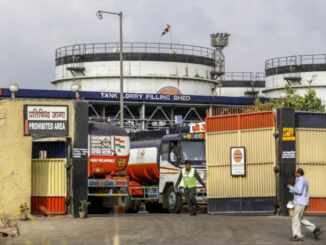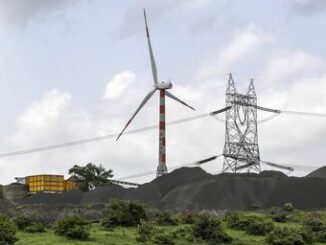
The case for its economic ascent is strong, but government policies still stand in the way.
Will India be the next China? As China’s economy spirals downward and optimism about India’s growth reverberates around the world, that question can no longer be dismissed as the fevered fantasy of nationalists. It needs to be taken seriously—not least because the world is already behaving as if India is a major power.
Consider this: In 2023, suspicion swirled that the Indian government was connected to the killing of a Canadian citizen on Canadian soil and a plot to kill a U.S. citizen on U.S. soil—a remarkable set of allegations. Yet even more remarkable than the allegations were the reactions. The U.S. government opted to douse the potentially incendiary fallout, saying little, merely allowing the case to wend its way through the courts. In other words, Indian hubris was accommodated, not chastised. It was a testament to India’s newfound political standing.
As for the economy, it is true that the Chinese experience of the last 40 years was a very specific type of miracle that is unlikely to be replicated. Even so, there is a case for India because it is no longer the economically constrained giant that it once was.
For the past quarter century, India’s development was hobbled by its infrastructure, inadequate to the nation’s own manufacturing needs and patently insufficient for foreign firms considering India as an export base. Over the last decade, however, its infrastructure has been transformed. The government of Prime Minister Narendra Modi has built roads, ports, airports, railways, power, and telecommunications, in such quantities that it has rendered the country almost unrecognizable from what it was just a few years ago. To give just one example, around 34,000 miles of national highways have been built since the current government came to power in 2014.
The nation’s digital infrastructure has also been transformed. Once creaky and technologically backward, it is now cutting-edge, with ordinary Indians using smartphones to pay for even the most routine shopping transactions. Even more crucially, the digital network now serves all Indians, allowing the government to introduce programs such as direct cash transfers to those in need, while the private sector has used it as a platform for entrepreneurship and innovation.
At the same time, the Modi government’s “New Welfarism” has enhanced Indians’ quality of life. This distinctive approach prioritizes the public delivery of essentially private goods and services, providing voters with clean fuel, sanitation, power, housing, water, and bank accounts while making clear to them that the benefactor is the prime minister. As a result of these programs, the state is now able to cushion the vulnerable with employment and free food during times of hardship like the COVID-19 pandemic. The capacity of the Indian state to build and deliver better—and at scale—has been remarkable.
These are major policy achievements, the fruit of cumulative and national efforts. Many of these initiatives were, in fact, started by previous central and state governments, though the Modi government deserves important credit for their accelerating progress. And there are signs that they are producing results.
To begin with, India has received a major new impetus to its skill-based service exports. India’s services first boomed in the early 2000s but plateaued after the 2008-09 global financial crisis. Now, they have seen a rebirth. In 2022, India’s global market share increased by 1.1 percentage point (about $40 billion), reflecting an important jump up the skills ladder. (In 2023, India likely gained further global market share but at a less torrid pace.)
Indians who used to write cheap code and man call centers are now running global capability centers, with high-skilled personnel performing analytical tasks for top global companies. JPMorgan Chase alone has more than 50,000 workers in India; Goldman Sachs’s largest office outside New York is in Bengaluru. Accenture and Amazon, among many others, also have large presences. This boom, in turn, has ignited the construction of high-rise apartments, which along with cranes are now dotting the skylines of the tech cities of Ahmedabad, Bengaluru, Hyderabad, Mumbai, and Pune. Sales of SUVs are soaring, and luxury malls and high-end restaurants are sprouting—all helped along by a boom in personal credit.
Next, there are signs that Uttar Pradesh, India’s most populous state and one of its least developed, is witnessing a revival. The state is refurbishing its decrepit infrastructure (not to mention its many temples), getting its finances under control, and reducing corruption and violence under its charismatic, sectarian leader, a vigilante Hindu monk-turned-politician. If the state can finally become an attractive investment destination, it has the potential to change the trajectory of the entire nation by dint of its sheer demographic heft. Its transformation would send the signal that India’s Hindi heartland—until recently pejoratively referred to as a bimaru, or diseased region—is not condemned to perpetual underdevelopment.
Finally, the downward spiral of the Chinese economy under President Xi Jinping has accelerated. As a result, capital is exiting that country at an alarming pace, with a net $69 billion in corporate and household funds leaving in 2023, according to official figures.
There are indications that a small share of this capital is finding its way to India. Most prominently, Apple has set up plants in a number of Indian states so that it can more readily supply the domestic market and diversify its export base, especially now that economic tensions between the United States and China are rising. And this, in turn, is helping to build a chain of domestic electronics suppliers, some of which are planning to set up large factories, especially in India’s south, employing more than 20,000 workers. This is an astonishing phenomenon in a country that has always been characterized by subscale, inefficient manufacturing firms.
If these large-scale plants prove viable, then they could spark a surge in goods exports, which would truly change prospects—not just for India’s long-beleaguered manufacturing sector but also for low-skilled workers who have not been able to enjoy the high-skill export service boom. The math is worth reflecting on. India’s low-skill exports will never reach Chinese levels of competitiveness, reflected in global market shares in excess of 40 percent. That’s because the unique set of political and economic circumstances that encouraged the advanced world to shift much of its industrial base to just one country no longer exists. But over the coming decade, it is perfectly feasible for India to increase its current share of around 3 percent by 5-10 percentage points, which would represent hundreds of billions of dollars of additional exports.
Despite the favorable portents, any declaration of India displacing China is premature. That’s because the encouraging signs are not yet convincingly reflected in the economic data, while government policies remain inadequate to realizing the new opportunities.
Consider the economic data. For some time, we have been skeptical of claims that India has really been able to put aside the lost decade of the 2010s, a period that saw modest growth, little structural transformation, and weak job creation. True, the economy has recovered post-COVID but in an unequal manner, favoring capital over labor, big firms over small, and the salaried middle class and the rich over the millions of people employed in the informal economy.
Part of the problem has been that India has so far managed to capitalize on only a small portion of the new opportunities created by the relative economic decline of China. Despite the government’s determined campaign to “Make in India,” it has not so far succeeded in convincing many firms to expand their Indian operations. In fact, inflows of foreign direct investment (FDI) have actually been declining. India also accounts for a smaller share of FDI flows to emerging markets excluding China.
This is not just a case of skittish foreigners. Even domestic firms have been reluctant to invest, notwithstanding the improved infrastructure that the government has created, the subsidies that it has offered, and, in some cases, the protectionism that it has lavished on the manufacturing sector. Private investment in plants and machinery has still not rebounded from the depressed levels of the last decade. And there are no convincing signs that this situation is about to turn around. In fact, new project announcements actually fell in nominal terms in 2023 compared with the previous year’s level.
Consequently, India’s manufacturing exports—the source of job creation for its vast pools of unskilled labor—remain weak. In fact, India’s global market share in key sectors such as apparel has declined since the global financial crisis. All this has been a major concern for Modi’s government and even the central bank, which recently issued a report urging the private sector to “get its act together” and relieve the government of the burden of investment.
Why have firms been so reluctant to seize the opportunities that lie so manifestly in front of them? Essentially, because they perceive that the risks of doing so are too high.
Firms’ concerns lie in three main areas. First, they are worried that the “software” of policymaking remains weak. The playing field is not level, as a few large domestic conglomerates and some large foreign companies are seen as favored firms, to the detriment of the broader investment climate. After all, for every favored firm that undertakes investments because its risks have been reduced, there are many competitors that have reduced their spending because their risks have increased. For them, the risks of being victims of arbitrary state action remain substantial.
Second, even as the government recognizes the need to boost exports, it remains viscerally attached to inwardness—that is to say, import barriers. This protectionism has a new allure because many people believe that India’s domestic market is now so large and its domestic firms so advanced that they can easily replace foreign firms, as long as they are given a boost from the government. Unsurprisingly so—economic nationalism inevitably accompanies political nationalism.
But the reality is that India’s domestic market is not particularly large, at least for the middle-class goods that global firms are trying to sell. And frequent announcements of protectionist measures actually undercut domestic investment, as firms become risk-averse, anticipating that they might sooner or later be cut off from critical foreign supplies. For example, the announcement last August that imports of laptops would be restricted sparked panic among firms in the important IT sector. In the end, the restrictions were watered down, but the fears still linger, especially as similar measures have been implemented in other sectors.
Above all looms the question of the wedge between politics and economics. Investment and growth can survive, even thrive, in the face of institutional decay as long as the political regime remains stable. And Modi’s popularity seems to portend stability. But rising disaffection and restiveness among minority communities, the southern states, the political opposition, and the farmers of northern India increase the likelihood of accidents. As the economist John Maynard Keynes famously remarked, the inevitable never happens. It is the unexpected, always.
We can glimpse hope in India’s present yet remain anxious about the future.


